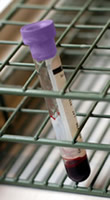Archival Notice
This is an archive page that is no longer being updated. It may contain outdated information and links may no longer function as originally intended.
Home | Glossary | Resources | Help | Contact Us | Course Map
Reference Sample Collection
Standard/reference samples (oral swabs from all victims) must be collected if a victim is not sure if collected evidence belongs to a suspect. These samples should be collected from all individuals who may be linked to the crime scene where DNA evidence is found or have come in physical contact with the item. Reference samples are used for elimination and comparative analysis. For example, buccal swab samples taken from the suspect and/or victim, a known source, are compared to biological evidence found at the crime scene to eliminate or place them at the scene.
Buccal Swab. Sterile swabs or other buccal collection devices are rubbed against the inside cheek of the individual's mouth to collect cells for analysis.
Procedure:
- Collect oral swabs from possible suspect(s)
- Collect oral swabs from victim(s)
- Collect oral swabs from known references (those with access to the scene, such as homeowners).
- Do not prewet swab.
- Rub dry swab on the inside of cheek until wet. Collect at least two swabs from cheeks.
- Identify item with donor's name on swab box.
- Thoroughly air-dry the swab before packaging. Alternatively, some boxes come with strategically placed holes to aid with drying after packaging.
Liquid Blood Sample Procedure (rarely encountered on scene):
- Collect in purple-topped vacuum tubes that contain the preservative ethylenediamine tetraacetic acid.
- Identify item with donor's name on blood tube.
- Refrigerate. Do not freeze or store near high heat (above 100° F) to prevent the glass from fracturing.
- Alert evidence officers of refrigerated samples.
Cigarette Butts:
- Select only the cigarette butts that may be of evidentiary value as a secondary reference sample.
- Ensure that the cigarette butts are thoroughly air dried before packaging.
- Do NOT handle with your bare fingers.
- Do NOT include the ashes.
Additional Online Courses
- What Every First Responding Officer Should Know About DNA Evidence
- Collecting DNA Evidence at Property Crime Scenes
- DNA – A Prosecutor’s Practice Notebook
- Crime Scene and DNA Basics
- Laboratory Safety Programs
- DNA Amplification
- Population Genetics and Statistics
- Non-STR DNA Markers: SNPs, Y-STRs, LCN and mtDNA
- Firearms Examiner Training
- Forensic DNA Education for Law Enforcement Decisionmakers
- What Every Investigator and Evidence Technician Should Know About DNA Evidence
- Principles of Forensic DNA for Officers of the Court
- Law 101: Legal Guide for the Forensic Expert
- Laboratory Orientation and Testing of Body Fluids and Tissues
- DNA Extraction and Quantitation
- STR Data Analysis and Interpretation
- Communication Skills, Report Writing, and Courtroom Testimony
- Español for Law Enforcement
- Amplified DNA Product Separation for Forensic Analysts


